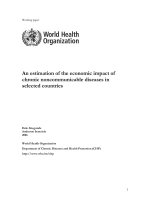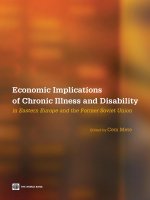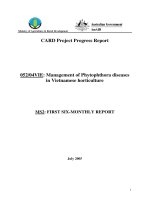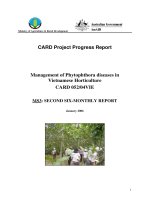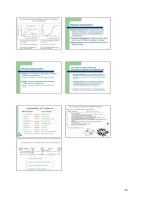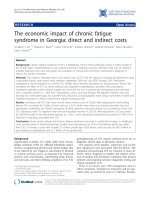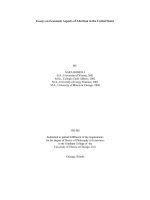Economic aspects of chronic diseases in vietnam
Bạn đang xem bản rút gọn của tài liệu. Xem và tải ngay bản đầy đủ của tài liệu tại đây (96.36 KB, 8 trang )
ORIGINAL ARTICLE
æ
Economic aspects of chronic
diseases in Vietnam
Hoang Van Minh1,*, Dao Lan Huong2, Kim Bao Giang1 and
Peter Byass3
1
Faculty of Public Health, Hanoi Medical University, Hanoi, Vietnam; 2World Bank Office in Vietnam,
Hanoi, Vietnam; 3Umea˚ Centre for Global Health Research, Umea˚, Sweden
Introduction: There remains a lack of information on economic aspects of chronic diseases. This paper, by
gathering available and relevant research findings, aims to report and discuss current evidence on economic
aspects of chronic diseases in Vietnam.
Methods: Data used in this paper were obtained from various information sources: international and national
journal articles and studies, government documents and publications, web-based statistics and fact sheets.
Results: In Vietnam, chronic diseases were shown to be leading causes of deaths, accounting for 66% of all
deaths in 2002. The burdens caused by chronic disease morbidity and risk factors are also substantial. Poorer
people in Vietnam are more vulnerable to chronic diseases and their risk factors, other than being overweight.
The estimated economic loss caused by chronic diseases for Vietnam in 2005 was about US$20 million
(0.033% of annual national GDP). Chronic diseases were also shown to cause economic losses for families
and individuals in Vietnam. Both population-wide and high-risk individual interventions against chronic
disease were shown to be cost-effective in Vietnam.
Conclusion: Given the evidence from this study, actions to prevent chronic diseases in Vietnam are clearly
urgent. Further research findings are required to give greater insights into economic aspects of chronic
diseases in Vietnam.
Keywords: chronic disease; economic burden; Vietnam
Received: 22 March 2009; Revised: 22 September 2009; Accepted: 22 September 2009; Published: 22 December 2009
hronic diseases consist of a wide range of conditions of long duration and generally slow progression. Chronic diseases are well known as
leading causes of mortality globally, representing 60%
of all deaths. Out of the 35 million people who died from
chronic diseases in 2005, more than 80% of these deaths
occurred in low and middle-income countries (1). The
number of deaths from chronic diseases will continue
increasing rapidly in the next decade and the low and
middle-income countries will carry the heaviest burden
(1, 2). Chronic diseases not only cause premature death,
but also have major adverse effects on the quality of life
of affected individuals and create large adverse economic
effects on families, communities and societies in general
(1). Four of the most prominent chronic diseases Á
cardiovascular diseases, cancer, chronic obstructive pulmonary disease and diabetes Á are linked to modifiable
risk factors, notably high blood pressure, tobacco use,
alcohol drinking, unhealthy diets and physical inactivity.
Currently, the prevalence rates of these risk factors are
accelerating globally, especially in developing countries
C
(3, 4). Actions to prevent these major chronic diseases
should focus on controlling these and other key risk
factors in a well-integrated manner. As many chronic
disease interventions are effective and suitable for resource-constrained settings (1, 5), it is vitally important
that action against the impending chronic disease pandemic is taken urgently.
Vietnam is located in Southeast Asia and shares
borders with China to the north and Laos and Cambodia
to the west. The country covers an area of area of 331,000
km2 and has a population of 85 million, with 50.8% of
the population estimated to be women and 49.2% men.
GDP per capita in Vietnam in 2007 was approximately
purchasing power parity dollars $3,000 (PPP) (6). Life
expectancy at birth (69 years for male and 74 years for
female in 2005) (7) and adult literacy rate (90.3% in 2004)
are high (8).
Like other developing countries, Vietnam is undergoing a rapid epidemiological transition resulting in an
increasing burden of chronic diseases. Chronic diseases
have been shown to be major causes of morbidity and
Global Health Action 2009. # 2009 Hoang Van Minh et al. This is an Open Access article distributed under the terms of the Creative Commons
Attribution-Noncommercial 3.0 Unported License ( permitting all non-commercial use, distribution, and
Citation: Global Health Action 2009. DOI: 10.3402/gha.v2i0.1965
reproduction in any medium, provided the original work is properly cited.
1
(page number not for citation purpose)
Hoang Van Minh et al.
mortality in hospitals for the whole country. Hospital
admissions due to chronic diseases increased from 39% in
1986 to 68% in 2002 and chronic diseases deaths rose
from 42% in 1986 to 69% in 2002 (9). To respond to the
problems of chronic diseases, the Vietnamese Prime
Minister issued Decision No. 77/2002/QD-TTg on the
Ratification of the Programme of Prevention and Control
of Certain Non-Communicable Diseases for the period
2002Á2010 (10). These documents highlight the importance of having comprehensive scientific evidence on
different aspect of chronic diseases, especially their socioeconomic patterning. This paper, by gathering available
relevant research findings, therefore aims to report and
discuss currently available evidence on economic aspects
of chronic diseases in Vietnam. The evidence on the
economic characteristics of this growing disease burden is
believed to be a firm background for justifying stronger
actions against chronic disease epidemics in Vietnam and
elsewhere.
Methods
Data used in this paper were obtained from the different
information sources: international and national journal
articles and studies, government documents and publications, web-based statistics and fact sheets. We used both
online and manual search methods to gather the information.
The online search was performed in multiple electronic
bibliographic databases, including: Ovid MEDLINE,
PubMed and EMBASE. The following main key search
terms were used: chronic disease, non-communicable
disease, cardiovascular disease, cancer, diabetes or
chronic obstructive pulmonary disease) and economic,
cost, price, expenditure, expenses or spending and
Vietnam; hypertension, high blood pressure, tobacco
use, smoking, alcohol use, drinking, diet, overweight,
obesity or physical activity and economic, cost, price,
expenditure, expenses or spending and Vietnam. In
addition, search engines such as Google and Google
Scholar were also used.
Manual searches were done in the Vietnam National
Library as well as in libraries of different institutions,
such as the Ministry of Health, Hanoi Medical University, Hanoi School of Public Health, Health Strategy
and Policy Institute of Vietnam and other Non-Governmental Organisations in Vietnam. Both English and
Vietnamese research reports conducted in Vietnam
within the last 10 years were included.
Chronic diseases were shown to be leading causes of
deaths. An estimate by WHO showed that, out of 516,000
deaths which occurred in 2002 in Vietnam, 341,000 (66%)
were attributable to chronic diseases (mainly ischaemic
heart disease, cerebrovascular disease and chronic obstructive pulmonary disease). The age-standardised mortality rate from chronic diseases was 664.1 per 100,000
population (11).
The burden of morbidity from chronic diseases in
Vietnam was also substantial. According to national
statistics, from 1986 to 2003, the proportion of all
hospital admissions attributable to chronic diseases
increased from 39 to 68% (12, 13). Data from cancer
registries in Vietnam showed that, in 2000, the total
number of cancer cases in the whole country was 68,810
(36,024 men and 32,786 women). The crude prevalence of
cancer was 91.5 per 100,000 in men and 81.5 per 100,000
in women. These figures are similar to those in other
developing countries and lower than those of developed
countries (14). The National Diabetes Survey, conducted
in 2002, showed a prevalence of 2.7% for the whole
country, ranging from a lower rate of 2.1% in more
remote mountainous areas to 4.4% in the major cities.
The survey also revealed prevalence of impaired glucose
tolerance of 7.3%, indicating the potential for sharp
future increases in diabetes prevalence (15). A population-based study in rural Vietnam found that 39% of
people aged 25Á74 years old reported at least one chronic
disease. More than 10% of them reported having two or
more chronic conditions (16).
Risk factors for chronic diseases were also common in
Vietnam. In 2002, 16.8% of Vietnamese aged 25Á64 years
old were shown to be afflicted by hypertension (17).1 The
prevalence of cigarette smoking in men and women in
2002 was 56.1 and 1.8%, respectively (18). In 2004, data
from WHO showed that the prevalence of heavy and
hazardous alcohol drinking2 among men and women was
5.7 and 0.6%, respectively (19). A recent study reported
that the prevalence of overweight in Vietnam has increased sharply during 1992 and 2002 (from 2.0 to 5.7%).
Significant increases were observed for men and women,
in urban and rural areas, and for all age groups (20).
Economic determinants of chronic diseases and their
related risk factors in Vietnam
There are several methods for assessing economic status
of households in Vietnam, such as official economic
classification, household income, household expenditure,
housing condition and assets. The association between
Results
1
Burden of chronic diseases and their related risk
factors in Vietnam
Table 1 presents the information on the burden of chronic
diseases and their related risk factors in Vietnam.
2
(page number not for citation purpose)
Hypertension was defined as systolic blood pressure (SBP) equal to
or more than 140 mmHg or diastolic blood pressure (DBP) equal to
or more than 90 mmHg or being treated for hypertension (I, IV).
2
Heavy and hazardous alcohol drinking was defined as average
consumption of 40 g or more of pure alcohol a day for men and 20 g
or more of pure alcohol a day for women.
Economic aspects of chronic diseases in Vietnam
Table 1. Burden of chronic diseases and their related risk factors in Vietnam
Source
World Health Organization
Method used
Data date
Modelling
2002
(2002)
Key findings
Number of deaths due to chronic diseases in 2002 was
341,000 (66% of total deaths). Age-standardised
mortality rate from chronic diseases was 664.1 per
100,000 population
Ministry of Health of Vietnam
(1987, 2003)
Hospital statistics
National Cancer Institute
Registry
1996Á2003
Proportion of all hospital admissions attributable to
chronic diseases increased from 39% in 1986 to 68%
2000
Number of cancer cases in the whole country was 68,
in 2003
(2008)
810 (36,024 men, 32,786 women) Prevalence of cancer
was 91.5 per 100,000 in men and 81.5 per 100,000 in
women
Binh et al. (2002)
Cross-sectional survey
2002
Prevalence of diabetes was 2.7% (all ages)
Cockram et al. (2006)
Cross-sectional survey
2002
Prevalence of impaired glucose tolerance was 7.3%
(all ages)
Ministry of Health of
Cross-sectional survey
2002
Prevalence of hypertension among Vietnamese aged
Cross-sectional survey
2003
Prevalence of cigarette smoking in 2002 was 56.1% in
Review
2004
Prevalence of heavy alcohol drinking was 5.7% in men
Vietnam (2003)
Ministry of Health of
25Á64 years old was 16.8%
Vietnam (2003)
World Health Organization
men and 1.8% in women (aged 25Á64 years old)
(2004)
and 0.6% in women (aged 25Á64 years old)
Nguyen et al. (2007)
Cross-sectional survey
1992Á2002
Minh et al. (2008)
Cross-sectional survey
2005
Prevalence of overweight increased from 2.0% in 1992
to 5.7% in 2002 (all ages)
Prevalence of self-reported chronic illness among
people aged 25Á74 years was 9%
economic status and chronic disease mortality, morbidity
and risk factors has been examined in a few studies in
Vietnam.
Table 2 shows information on the economic determinants of chronic diseases and their related risk factors in
Vietnam. Regarding mortality data, applying verbal
autopsy methods (21)3 enabled the assessment of causespecific mortality (22). Minh et al. previously demonstrated a possibly rising burden of mortality from
cardiovascular disease among the worse-off (23, 24).4
This finding is contrary to the frequent supposition that
chronic diseases mainly affect rich people. International
literature has also shown that, in almost all countries, it is
the poorest people who are most at risk of developing
chronic diseases and dying prematurely from them (1).
3
The method uses information obtained from close relatives or
caretakers of a deceased person about the circumstances, signs and
symptoms during the terminal illness in order to assign the most
likely cause of death.
4
Economic status was assessed by local authorities based on income
per person per month. The poor were defined to have an average
income per person per month of less than 15 kg rice or about 3.3
USD (according to Decision number 59 Á Ministry of Labour,
Invalids and Social Affairs).
Little research has been conducted in Vietnam on
associations between economic status and morbidity
from chronic diseases. In a study in rural Vietnam,
economic status was found to be inversely correlated
with the probability of having at least one chronic disease
among women only (i.e. the poorest women had a
significantly higher probability of having at least one
chronic disease than better-off women) (16). A complex
relationship between hypertension and economic status
was also revealed by other studies in the same study
setting, reporting that richer men and poorer women had
increased risks of being hypertensive as compared with
people of the same gender in the average living standard
group (25, 26). A relatively higher prevalence of selfreported chronic disease and hypertension among poor
women could possibly be explained by Barker’s hypothesis about infant origins of chronic adult diseases (27Á29).
In term of relationships between risk factors for
chronic diseases and economic status, findings from the
Vietnam National Health Survey in 2002 indicated that
tobacco smoking and alcohol drinking were more prevalent among the poor people than among the better-off
(10). Similarly, another Vietnamese research showed a
significantly lower risk of becoming a regular smoker and
the higher chance for cessation among the high-income
3
(page number not for citation purpose)
Hoang Van Minh et al.
Table 2. Economic determinants of chronic diseases and their related risk factors in Vietnam
Source
Minh et al. (2003, 2006)
Method used
Longitudinal study
Data date
1999Á2000
1999Á2003
Minh et al. (2008)
Cross-sectional survey
2005
Key findings
No significant difference in mortality rates from
cardiovascular disease by economic status
The poorest women had a significantly higher
probability of having at least one chronic disease
Ministry of Health of
Cross-sectional survey
than better-off women
Tobacco smoking and alcohol drinking were more
2002
Vietnam (2003)
prevalent among the poor people than among the
better-off
Minh et al. (2005)
Cross-sectional survey
2002
Significantly lower risk of becoming a regular
smoker and the higher chance for cessation among
the high-income group compared to lower-income
group
Anil et al. (2000) and
Bales et al. (2003)
Cross-sectional survey
2000 and 2002
Nguyen et al. (2007)
Cross-sectional survey
1992Á2002
Income appears to exert strong effect on the
decision to both initiate and to cease smoking
Higher rates of overweight among the higherincome people
group compared to lower-income group (30). Some other
studies have shown that income appears to exert strong
effects on the decision to both initiate and to cease
smoking (31, 32).
A recent study by Nguyen et al. (20), based on three
national surveys of socio-economic factors and health
conducted over 10 years in Vietnam, reported higher rates
of overweight among people with higher incomes. However, this study also showed that as the national income
rose, higher rates of overweight began to be observed even
among lower-income women. These observations are
consistent with the international literature on obesity
and inequities in health in the developing world (33).
In summary, our available research findings illustrate
the fact that chronic diseases are no longer to be
considered as ‘diseases of affluence’. These results demonstrate the shift from ‘early to later adopter’ of
cardiovascular diseases (CVD) epidemic (34). Poorer
people in Vietnam are more vulnerable to chronic diseases
and their risk factors, except overweight. The poor are
more likely to be afflicted by chronic diseases because of
material deprivation and psychosocial stress, higher levels
of risky behaviour, unhealthy living conditions and
limited access to good-quality health care, etc. (1).
Economic costs of chronic diseases and their related
risk factors in Vietnam
Table 3 summarises research findings on the costs of
chronic diseases and their related risk factors in Vietnam.
Chronic diseases are a major cost and a profound
economic burden to societies. The macroeconomic costs
due to chronic diseases include direct costs (costs of
medical care in relation to prevention, diagnosis and
4
(page number not for citation purpose)
treatment of disease), indirect costs (loss of human
resources caused by morbidity or premature death) and
intangible costs (pain, stress, anxiety and suffering, etc.).
These costs are usually estimated using accounting or
cost-of-illness methods. The total cost is equal to the total
time lost through premature death and illness multiplied
by a wage rate, and sometimes accounting for unemployment. The sums of direct and indirect costs are then
assumed to amount to a loss of GDP (1).
Abegunde et al. (35), employing a modelling approach,
have estimated macroeconomic losses attributable to
coronary heart disease, stroke and diabetes in 23 countries in 2005. The estimated figure for Vietnam was about
US$20 million (accounting for 0.033% of annual national
GDP). The estimate would almost double by 2015 if no
intervention were made. The accumulated losses in GDP
due to chronic diseases in Vietnam between 2006 and
2015 could therefore be as much as US$270 million. The
figure for Vietnam was lower than that of other developing countries in the region like Indonesia (cumulative
losses of US$4.18 billion), Thailand (US$1.49 billion)
and the Philippines (US$620 million) (35). The modelling
approach might be expected to yield lower results then
the cost-of-illness method (35).
A recent empirical cost-of-illness study on the costs of
smoking in Vietnam reported that the total cost of
inpatient health care caused by smoking in Vietnam
reached at least as much as US$77.5 million in 2005.
This represents about 0.22% of Vietnam’s GDP and 4.3%
of total healthcare expenditure. The majority of these
expenses are related to chronic obstructive pulmonary
disease (COPD) treatment (US$68.9 million per year)
followed by lung cancer (US$5.2 million per year) and
Economic aspects of chronic diseases in Vietnam
Table 3. Economic costs of chronic diseases and their related risk factors in Vietnam
Source
Abegunde et al. (2007)
Method used
Modelling
Data date
2005
Key findings
Losses because of coronary heart disease, stroke and diabetes were
about US$20 million (0.033% of annual national GDP). This figure would almost
doubled by 2015. The accumulated losses in GDP due to chronic diseases
in Vietnam between 2006 and 2015 could be as much as US$270 million
Ross et al. (2007)
Cross-sectional
survey
2005
Cost of inpatient health care caused by smoking was US$77.5 million
(0.22% of Vietnam GDP and 4.3% of total healthcare expenditure) including
COPD treatment (US$68.9 million per year), lung cancer (US$5.2 million per
year) and ischaemic disease (US$3.3 million per year)
Hien (2004)
Cross-sectional
2003
19% of rural dwellers with diabetes had to sell assets, using savings or
Thuan et al. (2006)
Longitudinal
2003
Household expenditures on treatment of chronic disease illness were also
Wagstaff et al. (2007)
Cross-sectional
survey
2002
Vietnamese households have not been able to hold their food and non-food
consumption constant in the face of income reductions
General Statistics
Cross-sectional
2004
The expenditure on smoking and drinking of a household
2002
Tobacco spending of low-income households represents a
2003
Average annual household expenditure on tobacco of US$39.8.The ratio of
survey
borrowing from neighbours to pay for health care costs
study
considerable and even reached ‘catastrophic’ levels
and extra medical care spending because of chronic illness
Office of Vietnam (2006) survey
Van Kinh et al. (2006)
Cross-sectional
Hoang M et al. (2004)
Cross-sectional
in Vietnam made up 3Á4% of total recurrent expenditure of that household
survey
survey
larger proportion of their expenditure than for higher-income households
tobacco spending to education expenditure was 228% in the poorest
households. 11.3% of poor households would escaped from food poverty
situation if they had spent their available money on food instead of on tobacco
ischemic disease (US$3.3 million per year). The government directly finances about 51% of these costs. The rest is
financed either by households (34%) or by the insurance
sector (15%). The true costs would be substantially higher
if all smoking-related diseases, outpatient care and
mortality-related costs were included (36).
Chronic diseases were also shown to cause economic
losses for families and individuals in Vietnam. A study
from Northern Vietnam reported that 19% of rural
dwellers with diabetes had to sell assets, use savings or
borrow from neighbours to pay for health care costs (37).
Another study reported that household expenditures on
treatment of chronic disease illness were also considerable
and even reached ‘catastrophic’ levels (38).5 Wagstaff
found that Vietnamese households have not been able to
hold their food and non-food consumption constant in
the face of income reduction and extra medical care
expenditure due to chronic illness (39).
Consumption of tobacco and alcohol, two established
chronic disease risk factors, were also shown to have
negative impacts on Vietnamese households’ economies.
Vietnam Living Standard Surveys found that, on average,
the expenditure on smoking and drinking of a household
in Vietnam made up 3Á4% of total recurrent expenditure
5
Catastrophic spending occurs when health care expenditure for a
household exceeds 40% of the households’ capacity to pay.
of that household (i.e. expenditures on food, electricity,
water, telephone, fuel, health care and education) (40Á42).
Kinh et al. found that the tobacco spending of lowincome households represents a larger proportion of their
expenditure than for higher-income households. Lowincome households’ tobacco spending is equal to oneand-a-half times their educational spending and is
equivalent to health care spending. By contrast, tobacco
expenditures for higher-income households are 46 and
69%, of educational and health expenditures, respectively
(43). Another household survey, conducted in five
provinces in Vietnam in 2003, reported an average annual
household expenditure on tobacco of US$39.8. The ratio
of tobacco spending to education expenditure was 228%
in the poorest households. The study also analysed the
influence of cigarette smoking on poverty by estimating
the potential reduction in the percentage of poor
households if money spent on tobacco was used instead
to buy food. According to this study, 11.3% of poor
households could escape from food poverty situations if
they spent their available money on food instead of on
tobacco (44).
Economic aspects of interventions against chronic
diseases
Table 4 presents evidence on the economic aspects of
interventions against chronic diseases. Available evidence
5
(page number not for citation purpose)
Hoang Van Minh et al.
Table 4. Economic aspects of interventions against chronic diseases
Source
Levy et al. (2006)
Method used
Key findings
Modelling
The effect of a combination of policies (100% tobacco tax increase; comprehensive worksite
and restaurant smoking bans with enforcement and publicity; a high-intensity media
campaign; higher enforcement and publicity of the total ban on cigarette advertisements and
strong health warnings; and strict youth access controls) would result in a reduction in smoking
Asaria et al. (2007)
Modelling
of about 29.6% in males and 22.4% in females in the immediate future
Reducing salt intake and implementing 4 key elements of the WHO Framework Convention on
Tobacco Control would reduce 40Á80 deaths per 100,000 populations older than 30 years. The
cost of the two approaches separately and combined would be $0.04, $0.11 and $0.16 per
person per year, respectively
Lim et al. (2007)
Modelling
Treatment of high-risk individuals with aspirin, blood pressure-lowering drugs and cholesterollowering drugs would be estimated to avert 266,000 deaths over the period 2006Á2015. The
average cost per treated individual per year would be $0.60
shows that there is a full range of cost-effective interventions against chronic diseases (1, 34, 45, 46). However,
little is known about the effects and cost-effectiveness of
different types of interventions against chronic diseases in
Vietnam. Recent work by Levy et al. (47), using the
SimSmoke model, showed that the overall effect of a
combination of policies, representing a 100% tobacco tax
increase; comprehensive workplace and restaurant smoking bans with enforcement and publicity; a high-intensity
media campaign; higher enforcement and publicity for
the total ban on cigarette advertising and strong health
warnings; and strict youth access controls would result in
a reduction in smoking of about 29.6% in males and
22.4% in females in the immediate future. By 2033,
smoking prevalence is projected to drop by 38.5% for
males and 31.8% for females. Between 231,500 and
325,000 lives would be saved by 2033.
Asaria et al. (48), using a modelling approach, have
provided estimates on cost-effectiveness of two population-wide interventions (reducing salt intake and implementing four key elements of the WHO Framework
Convention on Tobacco Control) in 23 countries. The
intervention strategies would be cost-effective and have
substantial impacts in reducing the burden of chronic
diseases. For Vietnam, during 2006Á2015, expected
deaths averted, as a result of these two interventions,
would be about 40Á80 per 100,000 populations older than
30 years. Total expenditure for implementing the salt
intervention, tobacco interventions,6 and combination of
the two approaches would be $0.04, $0.11, and $0.16 per
person per year, respectively. Total costs of the two
interventions would therefore account for about 0.5% of
government health spending. According to this study, the
implementation of these interventions would be more
cost-effective in Vietnam than in other neighbouring
countries like China (the corresponding figures are $0.05,
$0.14 and $0.20, respectively), the Philippines ($0.05,
$0.13 and $0.18) and Thailand ($0.06, $0.17 and $0.23)
(48).
Information on the cost-effectiveness of preventing
cardiovascular diseases in high-risk individuals have also
been shown in a simulation model by Lim et al. (49). The
exercise showed that treatment of high-risk individuals
with aspirin, blood pressure-lowering drugs and cholesterol-lowering drugs, to prevent cardiovascular disease,
would be effective and cost-effective in developing
countries. For Vietnam, a programme scaled-up up to
the target coverage of 80% would be estimated to avert
266,000 deaths over the period 2006Á2015. The average
cost per treated individual per year would be $0.66. This
cost includes resources for drugs, health service delivery,
screening and treatment, laboratories, administration,
monitoring and assessment of the programme. This
high-risk individual intervention was shown to be potentially more cost-effective in Vietnam than in other
neighbouring countries like Thailand and Indonesia (49).
In 2005, to encourage action for preventing chronic
diseases, WHO proposed a global goal of a 2% yearly
decrease in projected age-specific death rates from
chronic diseases worldwide (2). In Vietnam, achievement
of the global goal would result in additional gains in
healthy life expectancy of 1.7 years and in healthy life
expectancy of 1.5 years (18).
6
Tobacco interventions include: increased taxes on tobacco
products; enforcement of smoke-free workplaces; requirements for
FCTC-compliant packaging and labelling of tobacco products
combined with public awareness campaigns about the health risks
of smoking; and a comprehensive ban on tobacco advertising,
promotion and sponsorship.
6
(page number not for citation purpose)
Discussion
We have shown that, at current stage of epidemiological
transition, Vietnam is heavily burdened by chronic
diseases, epidemiologically and economically. Existing
Economic aspects of chronic diseases in Vietnam
evidence indicates that prevention and control of chronic
diseases are feasible and cost-effective in Vietnam. Given
the evidence from this study, interventions against chronic
diseases in Vietnam should be comprehensive and integrated, including both primary and secondary approaches, as well as policy-level involvements. Primary
prevention towards increasing the population proportion
at low risk of developing chronic diseases (i.e. populationwide approach to reduce salt intake and tobacco use)
should be a priority. The aim should be to make small
improvements in a large proportion of the population.
Secondary prevention for early treatment of individuals
with established chronic diseases is also an important
component. This will help to reduce complication rates
and improve their quality of life. Cost-effective medication
(aspirin, low-cost diuretics and beta-blockers, etc.) need
to be available for use at all health care levels (50).
Policy-level interventions have a crucial role in the
prevention and control of chronic diseases in any country.
In Vietnam, concrete policy frameworks should be put in
place to strengthen the National Programme of Prevention and Control of Certain Non-communicable Diseases.
The programme should be integrated into the primary
health care system and other existing well-established
health programmes such as the Primary Health Care
Programme and Nutrition Programme, etc. This will help
reduce costs of prevention as well as taking full advantage
of existing capacity. Importantly, central and local Governments and Health Authorities should provide timely
special protection for vulnerable groups. These include
children, women, less educated people and the poor, who
usually have limited choices about the food they eat, their
living conditions, and access to education and health care.
There is also a need to increase the share of financial
resources allocated to prevention, which is currently very
limited. The Framework Convention on Tobacco Control,
which was ratified in Vietnam, should be further promoted
by passing laws against smoking.
This is a preliminary review of economic aspects of
chronic diseases in Vietnam. The evidence documented in
this paper may not yet be compelling. Further empirical
research findings are required to give greater insights into
the issues.
Acknowledgements
This review was conducted within the Umea˚ Centre for Global
Health Research, with support from FAS, the Swedish Council for
Working Life and Social Research (Grant No. 2006-1512).
Conflict of interest and funding
The authors have not received any funding or benefits
from industry to conduct this study.
References
1. World Health Organization. Preventing chronic diseases Á a vital
investment. Geneva: World Health Organization; 2005.
2. Strong K, Mathers C, Leeder S, Beaglehole R. Preventing
chronic diseases: how many lives can we save? Lancet 2005; 366:
1578Á82.
3. Bonita R, DeCourten M, Dwyer T, Jamrozik K, Winkelmann
R. Surveillance of risk factors for noncommunicable disease: the
WHO STEPwise approach. Geneva: World Health Organization; 2002.
4. Armstrong T, Bonita R. Capacity building for an integrated
noncommunicable disease risk factor surveillance system in
developing countries. Ethn Dis 2003; 13: 13Á8.
5. Ackland M, Choi BCK, Puska P. Rethinking the terms noncommunicable disease and chronic disease. J Epidemiol Community Health 2003; 57: 838Á9.
6. General Statistics Office of Vietnam. Statistical yearbook of
Vietnam 2007. Hanoi: General Statistics Office of Vietnam;
2008.
7. World Health Organization. The world health report 2007 Á a
safer future: global public health security in the 21st century.
Geneva: World Health Organization; 2007.
8. United Nations Development Programme. Human development
report 2006: beyond scarcity: power, poverty and the global
water crisis. New York: United Nations Development Programme; 2006.
9. Ministry of Health of Vietnam. Vietnam health statistics yearbook 2002. Hanoi: Ministry of Health Vietnam; 2003.
10. Viet Nam Prime Minister’s Office. Decision 77/2002/QD-TTg:
ratification of programme of prevention and control of certain
noncommunicable diseases for the period 2002Á2010; 2002.
11. World Health Organization. Global program on evidence for
health policy (EBD/GPE/EIP). Geneva: World Health Organization; 2002.
12. Ministry of Health of Vietnam. Vietnam health statistics yearbook 1997. Hanoi: Ministry of Health Vietnam; 1998.
13. Ministry of Health of Vietnam. Health statistic year book.
Hanoi: Ministry of Health of Vietnam; 2003.
14. Ministry of Health of Vietnam. The pattern of cancer in
Vietnam 2000. Hanoi: National Cancer Institute; 2008.
15. Cockram CS, Van Binh T, Galea G. Diabetes prevention and
control in Viet Nam: a demonstration project in two provinces.
Pract Diabetes Int 2006; 23: 361Á4.
16. Hoang Van M, Dao Lan H, Kim Bao G. Self-reported chronic
diseases and associated sociodemographic status and lifestyle
risk factors among rural Vietnamese adults. Scand J Public
Health 2008; 36: 629Á34.
17. National Heart Institute of Vietnam. Preparatory document for
the VIIth party congress; situation of cardiovascular disease.
Hanoi: Ministry of Health; 1996.
18. Ministry of Health of Vietnam. Vietnam National Health
Survey 2001Á2002. Hanoi: Ministry of Health Vietnam; 2003.
19. World Health Organisation. Global status report on alcohol
2004. Geneva: Department of Mental Health and Substance
Abuse; 2004.
20. Nguyen MD, Beresford SAA, Drewnowski A. Trends in overweight by socio-economic status in Vietnam: 1992 to 2002.
Public Health Nutr 2007; 10: 115Á21.
21. Reeves BC, Quigley M. A review of data-derived methods for
assigning causes of death from verbal autopsy data. Int J
Epidemiol 1997; 26: 1080Á8.
22. Huong DL, Minh HV, Byass P. Applying verbal autopsy to
determine cause of death in rural Vietnam. Scand J Public
Health 2003; 31: 19Á25.
7
(page number not for citation purpose)
Hoang Van Minh et al.
23. Minh HV, Byass P, Wall S. Mortality from cardiovascular
diseases in Bavi District, Vietnam. Scand J Public Health Suppl
2003; 62: 26Á31.
24. Hoang VM, Dao LH, Wall S, Nguyen TK, Byass P. Cardiovascular disease mortality and its association with socioeconomic status: findings from a population-based cohort study in
rural Vietnam, 1999Á2003. Prev Chronic Dis 2006; 3: A89.
25. Minh HV, Byass P, Chuc NT, Wall S. Gender differences in
prevalence and socioeconomic determinants of hypertension:
findings from the WHO STEPs survey in a rural community of
Vietnam. J Hum Hypertens 2006; 20: 109Á15.
26. Hoang VM, Byass P, Dao LH, Nguyen TK, Wall S. Risk factors
for chronic disease among rural Vietnamese adults and the
association of these factors with sociodemographic variables:
findings from the WHO STEPS survey in rural Vietnam, 2005.
Prev Chronic Dis 2007; 4: A22.
27. Barker DJ. The fetal and infant origins of adult disease. BMJ
1990; 301: 1111.
28. Barker DJ. Fetal origins of coronary heart disease. BMJ 1995;
311: 171Á4.
29. Barker DJ. The developmental origins of chronic adult disease.
Acta Paediatr Suppl 2004; 93: 26Á33.
30. Van Minh H, Ng N, Wall S, Stenlund H, Bonita R, Weinehall L,
et al. Smoking epidemics and socio-economic predictors of
regular use and cessation: findings from WHO STEPS risk
factor surveys in Vietnam and Indonesia. Int J Epidemiol 2006; 3.
31. Ramanan L, Anil D. Tobacco initiation, cessation, and change:
evidence from Vietnam. Health Econ 2004; 13: 1191Á201.
32. Bales S, Kinh HV. An empirical analysis of smoking using the
Vietnam living standard surveys. Hanoi: World Bank; 2003.
33. Monteiro CA, Conde WL, Lu B, Popkin BM. Obesity and
inequities in health in the developing world. Int J Obes Relat
Metab Disord 2004; 28: 1181Á6.
34. Leeder S, Raymond S, Greenberg H, Liu H. A race against time:
the challenge of cardiovascular disease in developing economies.
New York: The Center for Global Health and Economic
Development; 2004.
35. Abegunde DO, Mathers CD, Adam T, Ortegon M, Strong K.
The burden and costs of chronic diseases in low-income and
middle-income countries. Lancet 2007; 370: 1929Á38.
36. Ross H, Trung DV, Phu VX. The costs of smoking in Vietnam:
the case of inpatient care. Tob Control 2007; 16: 405Á9.
37. Hien PT. Health care expenditure among diabetes patients.
Hanoi: Institute for Health and Development; 2004.
38. Thuan NTB, Lofgren C, Chuc NTK, Janlert U, Lindholm L.
Household out-of-pocket payments for illness: evidence from
Vietnam. BMC Public Health 2006; 6: 283.
39. Wagstaff A. The economic consequences of health shocks:
evidence from Vietnam. J Health Economics 2007; 26: 82Á100.
8
(page number not for citation purpose)
40. Vietnam GSO. Vietnam Living Standard Survey 1997Á1998.
Hanoi: Statistical Publishing House; 2000.
41. Vietnam GSO. Vietnam Living Standard Survey 2002. Hanoi:
Statistical Publishing House; 2004.
42. Vietnam GSO. Vietnam Living Standard Survey 2004. Hanoi:
Statistics Publishing House; 2006.
43. Van Kinh H, Ross H, Levy D, Minh N, Ngoc V. The effect of
imposing a higher, uniform tobacco tax in Vietnam. Health Res
Policy Sys 2006; 4: 6.
44. Hoang M, Thu L, Efroymson D, FitzGerald S, Jones L, Tuan T.
Tobacco over education Á an examination of opportunity losses
for smoking households. Hanoi: Path Canada (HealthBridge)
Vietnam Office; 2004.
45. Nissinen A, Berrios X, Puska P. Community-based noncommunicable disease interventions: lessons from developed countries
for developing ones. Bull World Health Organ 2001; 79: 963Á70.
46. Nissinen A, Kastarinen M, Tuomilehto J. Community control of
hypertension-experiences from Finland. J Hum Hypertens 2004;
18: 553Á6.
47. Levy DT, Bales S, Lam NT, Nikolayev L. The role of public
policies in reducing smoking and deaths caused by smoking in
Vietnam: results from the Vietnam tobacco policy simulation
model. Soc Sci Med 2006; 62: 1819Á30.
48. Asaria P, Chisholm D, Mathers C, Ezzati M, Beaglehole R.
Chronic disease prevention: health effects and financial costs of
strategies to reduce salt intake and control tobacco use. Lancet
2007; 370: 2044Á53.
49. Lim SS, Gaziano TA, Gakidou E, Reddy KS, Farzadfar F,
Lozano R, et al. Prevention of cardiovascular disease in highrisk individuals in low-income and middle-income countries:
health effects and costs. Lancet 2007; 370: 2054Á62.
50. Pearson TA, Blair SN, Daniels SR, Eckel RH, Fair JM,
Fortmann SP, et al. AHA guidelines for primary prevention of
cardiovascular disease and stroke: 2002 update: consensus panel
guide to comprehensive risk reduction for adult patients without
coronary or other atherosclerotic vascular diseases. Circulation
2002; 106: 388Á91.
*Hoang Van Minh
Faculty of Public Health
Hanoi Medical University
No. 1 Ton That Tung, Dong Da
Ha Noi, Viet Nam
Tel: '84 4385 23798
Fax: '84 4357 45070
Email:


